Marantaceae family (Ctetanthe, Goeppertia, Maranta, and Stromanthe spp.)
If you’re on a quest to add a houseplant with striking foliage to your collection, look no further – you can take your pick from an array of gorgeous leaf patterns among the prayer plants.
These dazzling plants – marantas, calatheas, stromanthes, and ctenanthes – have colorful, patterned leaves that lift upward in the evening, giving them their common name.
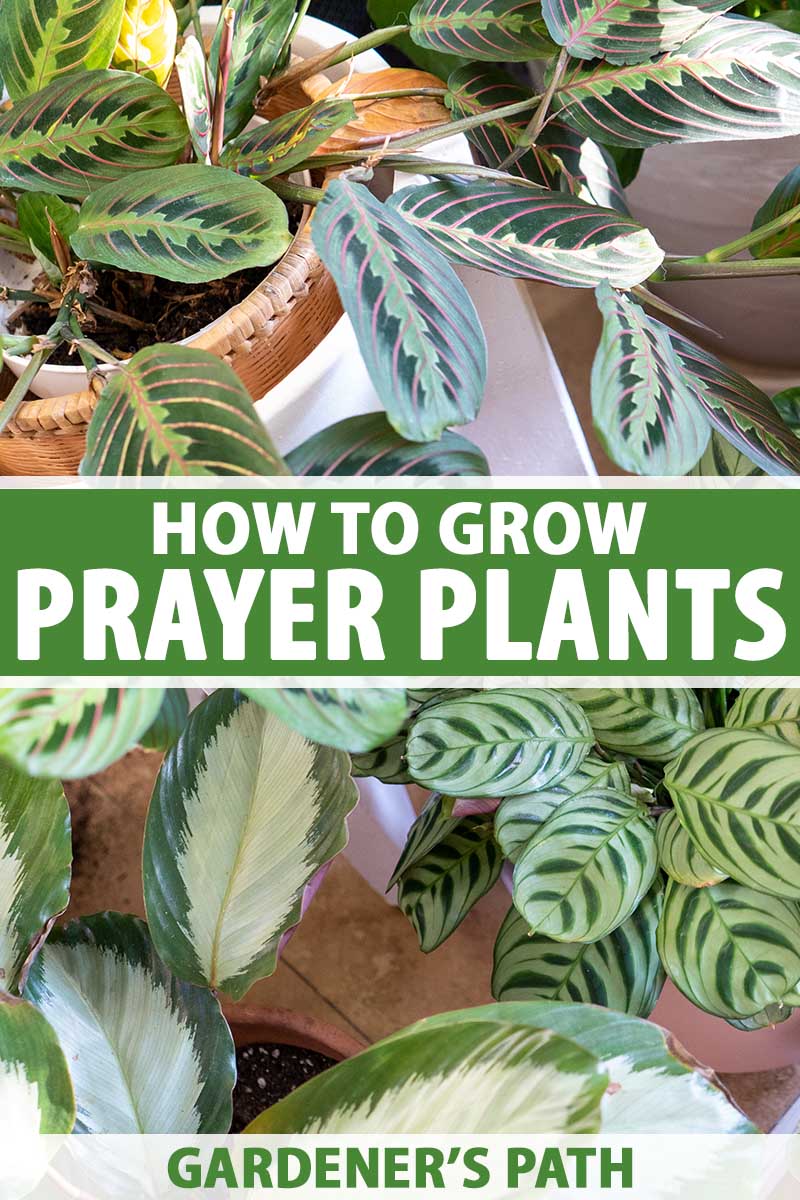
We link to vendors to help you find relevant products. If you buy from one of our links, we may earn a commission.
While these species are not ones you’d place into the “low maintenance houseplant” category, as a plant parent, you may find their stunning foliage and fascinating daily rhythms worth the slightly increased efforts required to keep them thriving.
And they do come with certain advantages: they are both non-toxic to pets and do well in lower light conditions.
On the other hand, one of the very real potential disadvantages to acquiring one of these is that you may not be able to stop with just one.
There’s something about them that makes you want to start a collection. I may be speaking from experience. Maybe…
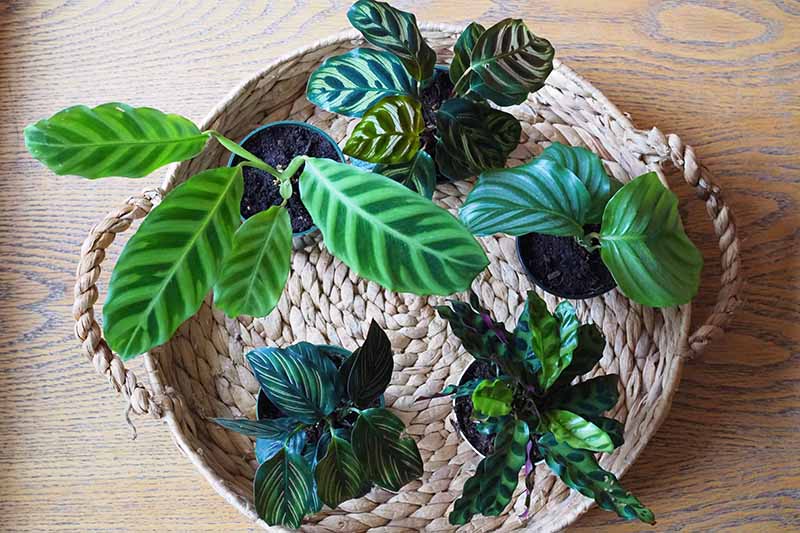
Whether you think you’d be happy to have just one, or are ready to join me in the ranks of prayer plant collecting fanatics, I’m going to guide you through everything you need to know about growing these lovelies in your home, so you can keep them healthy and let their beautiful foliage shine.
Here’s a preview of what’s to come:
What You’ll Learn
What Are Prayer Plants?
“Prayer plant” is a name given to many different species of herbaceous evergreen perennials in the arrowroot family, Marantaceae.
Also often described as “the prayer plant family,” this taxonomic grouping is made up of 31 different genera, and roughly 550 different species.
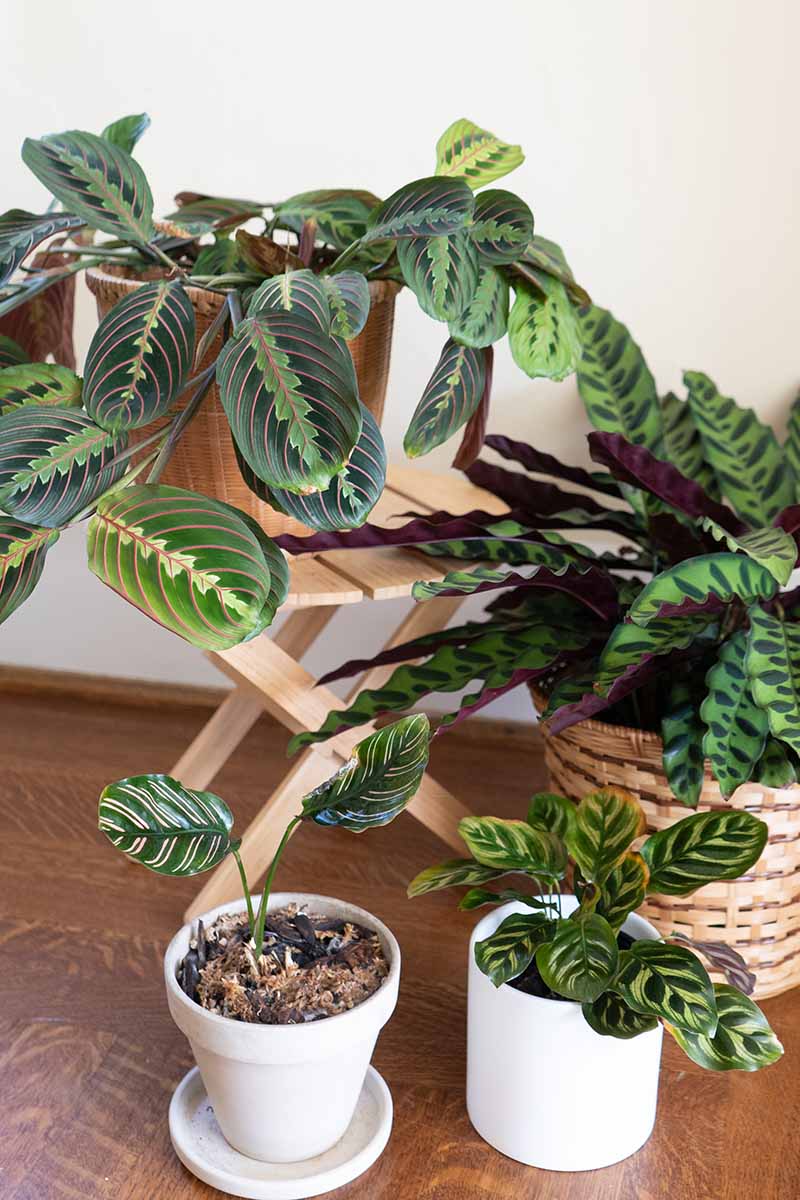
In this article, I’ll focus on those members of the arrowroot family that are commonly grown as ornamental houseplants, including species from the Ctetanthe, Goeppertia, Maranta, and Stromanthe genera.
If you’re looking for care instructions for Calathea species and are disappointed not to see them included here, don’t worry – they will be! These have been reclassified as members of a different genus, and I’ll explain this shortly.
Many of the species in these different but closely related genera have very similar characteristics and growing requirements.
So, whether you came here looking for information on how to grow Calathea orbifolia or Maranta leuconeura, the basic care guidance provided will work for your specific houseplant.
The Great Calathea Reclassification
If you have a calathea of some sort, you may – or may not – be aware that these species have more current official aliases.
It all happened during the Great Calathea Reclassification of 2012. Okay, that title is my own invention, but the reclassification did indeed happen.
In 2012, Finn Borchsenius, Vice Dean for Education, Science, and Technology at Aarhus University in Denmark, along with colleagues Luz Suarez and Linda MacKechnie, published a paper entitled “Molecular Phylogeny and Redefined Generic Limits of Calathea (Marantaceae)” in the journal Systematic Botany.
The authors of this paper explained that after their DNA analysis of the species in this genus, they actually found two distinct “clades,” or groups, among the calatheas – and they concluded that this genus needed to be redefined.
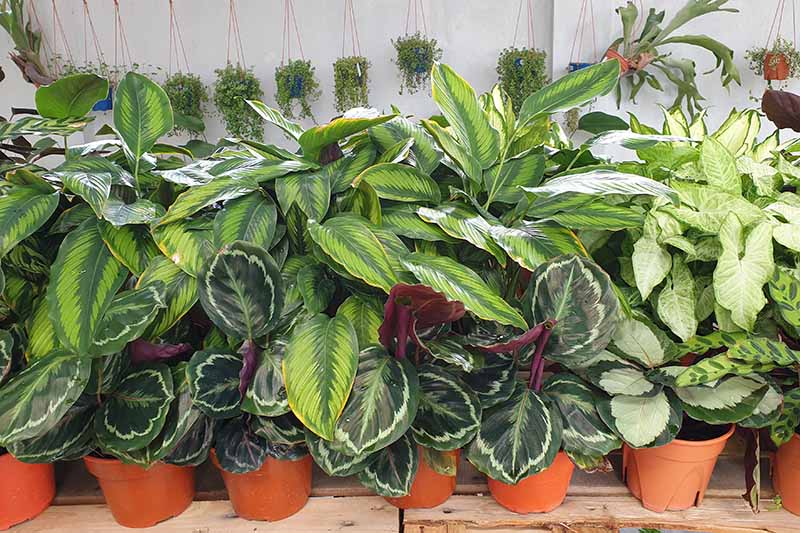
“Goeppertia” was an old, abandoned genus name for these species, so, as the authors of this paper wrote, “the genus Goeppertia is resurrected and redefined to include all members of the second Calathea clade.”
That second calathea clade comprised a group of approximately 248 species, leaving around 37 species behind in the Calathea genus.
Now renamed Goeppertia, that second calathea clade happens to contain all of the calatheas that are popular houseplants.
So officially, your lovely calathea houseplant is now a goeppertia.
But just so you know, houseplant enthusiasts and garden nurseries haven’t taken up the new taxonomic naming universally.
Old habits die hard, and this is not uncommon in the era of DNA analysis and reclassification, wherein many plants have been given new names in recent years.
When looking for any of these species or cultivars, you’ll still find them most commonly called calatheas rather than goeppertias.
Nyctinastic Movement
While the majority of calatheas may have, in name at least, moved to a different genus, they and their extended prayer plant family relatives are known for a different kind of movement, one that’s called “nyctinasty.”
No, this isn’t some overly suggestive line dance you haven’t heard of yet. Nyctinasty is a scientific term used to describe plant movement in response to darkness.
These nyctinastic species have the quirk of folding up their leaves for the night, and then lowering them again when the sun returns in the morning.
It was the nighttime lifting of their leaves that made horticulturalists think of hands held vertically in prayer and inspired their common name.
However, these species don’t follow the direction of the sun throughout the day, like sunflowers do. Instead, they exhibit a different type of movement.
During the day, their foliage is stretched out horizontally.
When the sun goes down, their leaves raise upward – and in some species, the undersides of the leaves are exposed.

This movement follows a circadian rhythm, one that lasts over the course of 24 hours.
In case you’re wondering, members of the arrowroot family aren’t the only plants that move in reaction to the daily patterns of sunset and sunrise.
Papaya trees and mimosa, aka sensitive plant – as well as many other types of legumes, such as garden peas – exhibit movement as part of their circadian rhythm.
There are different hypotheses about why Marantaceae species have evolved this daily rhythm. Some think this is a way for these species to protect their foliage from fungal and bacterial growth at night.
Bacteria and fungi have an easier time getting a foothold in dark, cool, damp conditions.
Since water doesn’t sit on leaves that are arranged vertically like it does on horizontal ones, raising their leaves would allow water to run off and keep them dry at night when conditions are dark and cool.
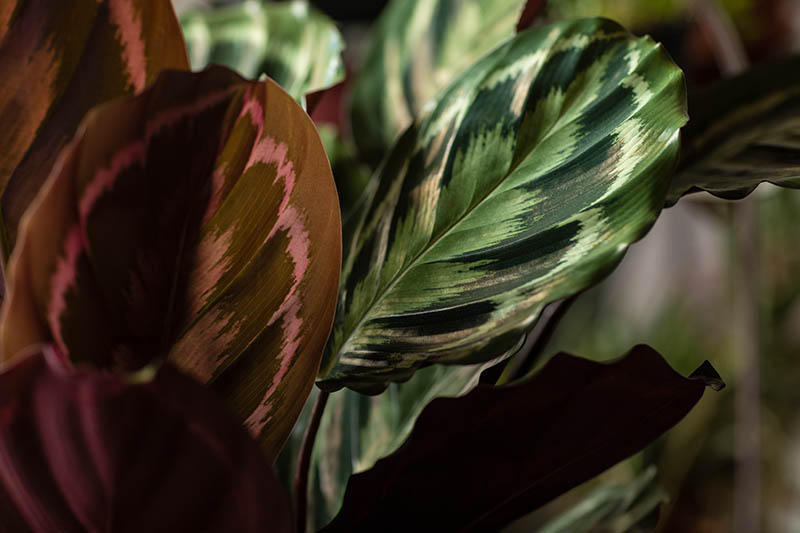
Another interesting hypothesis as to the reason for this daily rhythm is that it might be a strategy these tropical species have evolved to protect themselves from nibbling herbivores.
Lifting their leaves may give nocturnal predators a boost, providing less cover for herbivore populations seeking food on the rainforest floor. The predators have an easier time finding their prey, and the plants get a break from being nibbled on in exchange.
Whatever the evolutionary reason behind this daily rhythm, it’s a lot of fun having a houseplant that doesn’t just sit there – and it is perhaps a good reminder to observe an early bedtime!
Cultivation and History
While some members of the Marantaceae family are native to Africa and Asia, the ones we are going to focus on in this article are all native to tropical zones in the Americas and the Caribbean.
In their native range, they grow in dappled light on the moist rainforest floor – these conditions should give you a clue about what they’ll need once they’re living in your home.
The arrowroot family is part of the taxonomic order known as the Zingiberales.
This order includes some other ornamental members you have probably heard of before, such as birds of paradise and canna lilies, as well as some tropical members commonly used for food, including bananas, turmeric, and ginger.
In fact, some members of the Marantaceae family have flowers that bear a strong resemblance to ginger blossoms.
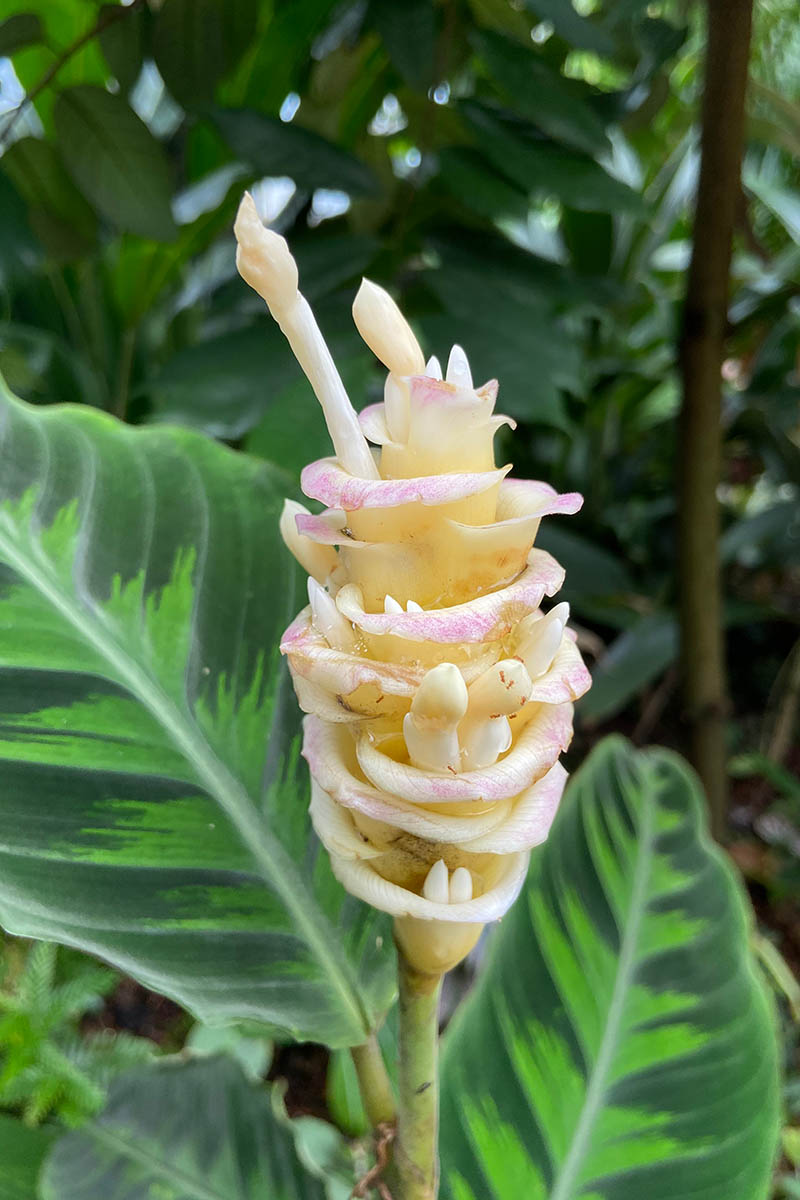
One species belonging to this family, Maranta arundinacea, is cultivated commercially as a food crop in the West Indies, China, and and southeast Asia for its edible rhizomes that are used to produce a gluten-free baking ingredient that goes by the name of “arrowroot starch.”
While arrowroot starch does help us gluten-free home cooks whip up some delicious baked goods, I would dare to say that these sweets cannot compare to the fantastic ornamental value of the plants in the arrowroot family. And from someone with a wicked sweet tooth, that’s saying a lot!
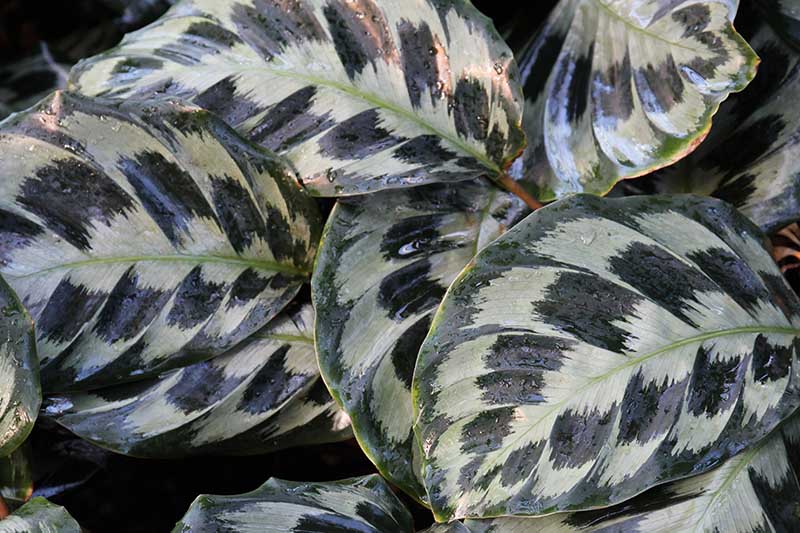
The Marantaceae family was named after a figure from the Italian Renaissance by the name of Bartolomeo Maranta, who was a literary critic, physician, and botanist – a true Renaissance man.
It wasn’t Bartolomeo Maranta himself who named this plant family, but rather Carl Linnaeus, the founder of modern taxonomy, who chose it in honor of him.
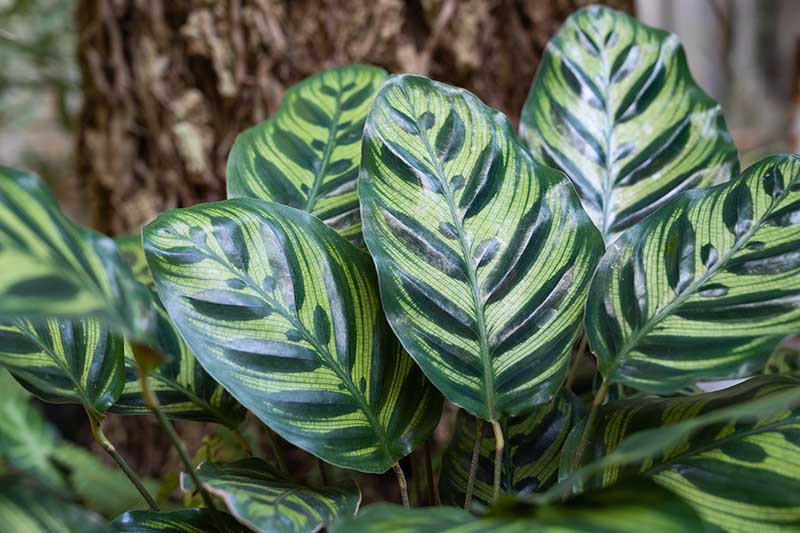
Members of the arrowroot family were first grown as specimens and cultivated in homes and greenhouses in Europe toward the end of the 1800s.
In fact, Charles Darwin was fascinated by plants in the Marantaceae family, performed experiments on them, and wrote about them in his book, “The Power of Movement in Plants.”
Fellow science geeks, you can get a copy of this lesser-known volume of Darwin’s oeuvre on Amazon.
Most of the prayer plant species that are grown as houseplants have striking coloring and symmetrical patterns – with stripes, blotches, and streaks in shades of dark green, light green, gray, silver, pink, white, and cream.
In addition to their intriguing patterns, most of these offer textural interest as well. Some species have foliage with raised textures to match their patterns, while others have wavy leaf margins.

And as new leaves unfurl, the undersides – frequently colored in purple or burgundy hues – are exposed, adding an additional visual delight that contrasts with their upper portions.
While the leaves of these plants are quite decorative, most of the species and cultivars enjoyed as houseplants produce tiny, inconspicuous flowers.
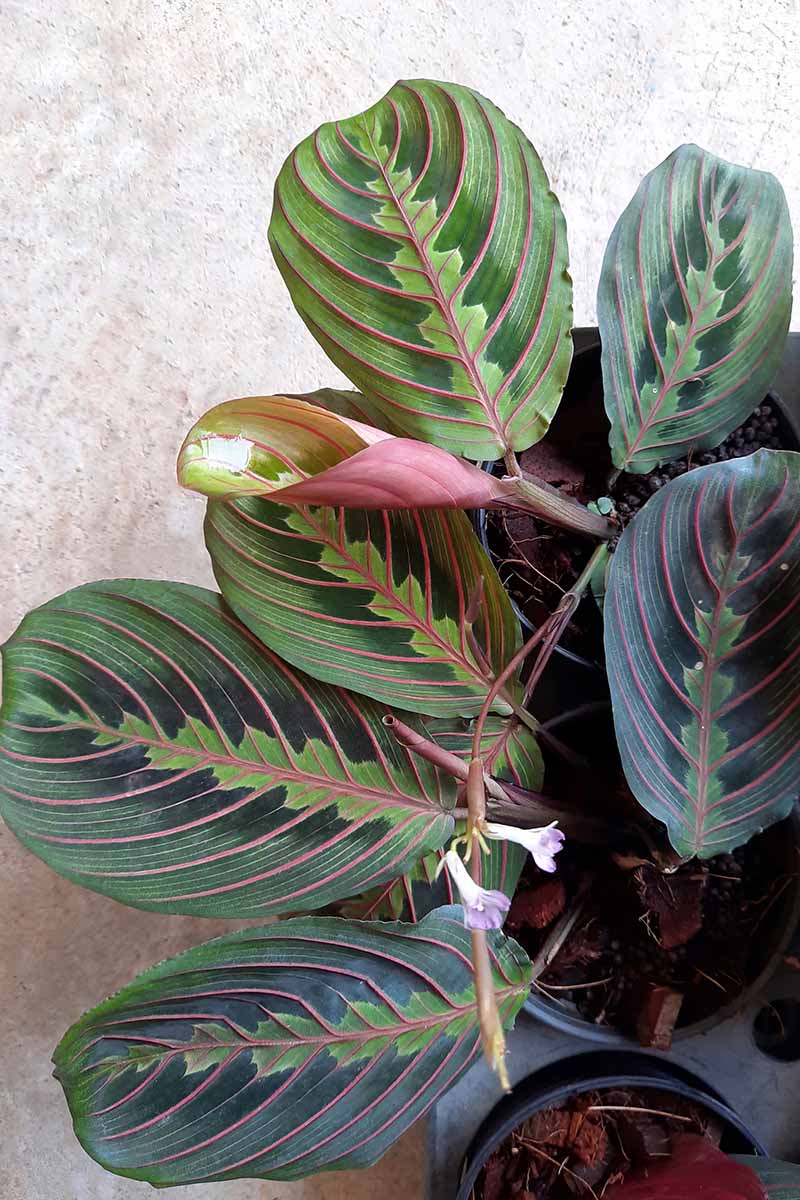
In USDA Hardiness Zones 11-12, members of the Marantaceae family can be featured outdoors in the landscape year round, but those of us in regions with cold winters must enjoy these beauties as houseplants.
Ready to find out how to grow and care for them in your home? Let’s start with propagation.
Propagation
One thing to consider before embarking on a prayer plant propagation project (say that three times fast) is that some hybrid varieties are protected under patent, and it is therefore not legal to propagate them by any means.
In other words, be careful to only propagate unpatented varieties or species plants.
Once you have determined that your selected cultivar is not protected under patent law, you may have a couple of different options when it comes to propagating these houseplants, depending on the type of prayer plant that you’re working with.
Starting from seed is not the easiest way to propagate these ornamentals. And it’s rare that they flower when kept indoors, which means seeds are hard to come by.
That leaves us with propagation from stem cuttings and through division. Let’s tackle division first.
By Division
Prayer plants produce underground rhizomes or tubers. When you divide these root structures, you can turn one specimen into two or more plants.
The best time to propagate through division is when you’re ready to repot – preferably in early spring.
Since younger specimens don’t survive division as well as more mature specimens, let your plant mature before dividing it. Check your plant label for the expected mature size of the type you are growing.

When you are ready to divide, carefully remove the plant from its pot. Follow the stems down to the roots – you will see separate clumps of stems attached to clumps of rhizomes or tubers. Separate out clumps with at least three leaves attached to them.
Finding a good spot to separate one clump from the others may be fairly easy and obvious, or they may be tightly packed, requiring you to work them apart.
Do this gently. You are basically performing surgery on your plant, so try to be as gentle as you would like a surgeon to be with you.
Repot the divided clump into a new container. You’ll find more details on how to do this in the repotting section below.
You can repot the parent plant into a new pot as well if it is now significantly smaller, or put it back into its old pot if it still fits nicely.
From Stem Cuttings
Marantaceae species that have a spreading growth habit can be propagated easily through stem cuttings. These include Maranta, Ctenanthe, and Stromanthe species.
Spreading types have nodes where they can grow new roots and anchor into the soil as they spread.
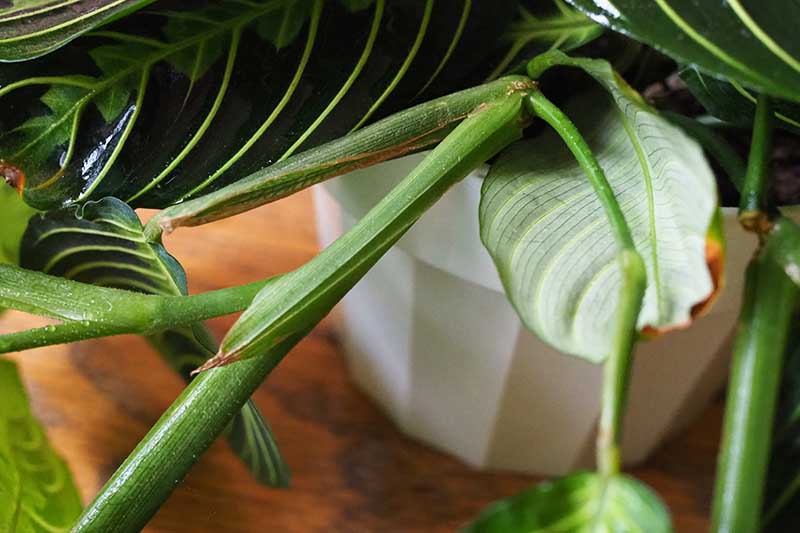
We can take advantage of this to create more houseplants. In fact, propagating from stem cuttings is how most marantas are grown commercially.
While the pros typically root these plants in potting medium of some sort, for most home gardeners, the most successful method for rooting a cutting of this type is to place the cut end in a glass of water and wait for roots to grow.
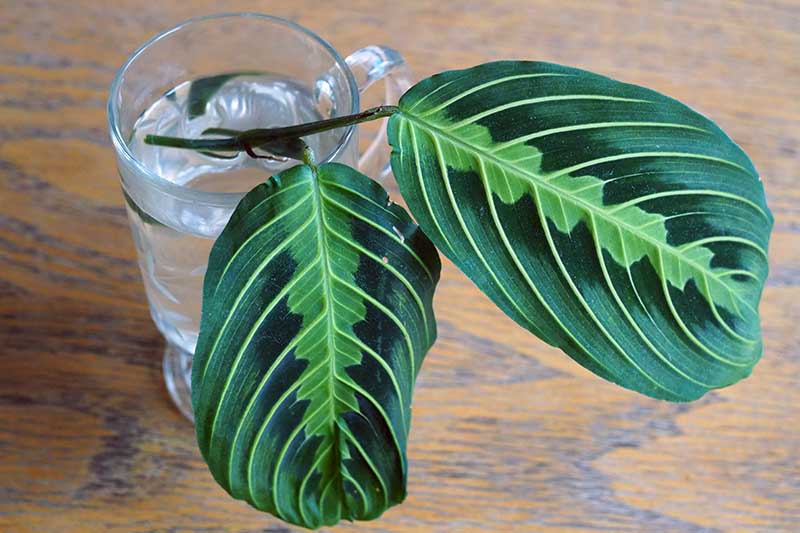
After several weeks or months, whenever your cuttings have established a thriving root system, you can pot them up by following the instructions in the repotting section of this article below.
You may be able to root some Goeppertia/Calathea species from cuttings as well, if they have a spreading habit.
None of the species I have encountered personally have nodes, which means they don’t have a built-in way to root along a stem. Division is probably your most reliable option for propagating these plants.
How to Grow
These green companions need a bit more attention than other houseplants, particularly regarding watering, humidity, and temperature.
Choosing a Plant
Let’s start before you even bring your maranta, calathea, stromanthe, or ctenanthe home, by choosing a healthy specimen.
Here are a few tips on what to look for:
- Examine the plant for signs of pests, making sure to look at the stems and base of stems, as well as the undersides of the leaves.
- Check the mature size of your selected variety and make sure you’ll have sufficient room for it before bringing it home.
- Look for foliage without browning or yellowing leaves, or leaves that look dry or wilted.
And when purchasing these houseplants from an online vendor, make sure a heat pack is included during winter if you live in a cold climate, so your purchase arrives without any chilling injury.
Light
As I mentioned earlier, these species grow on the rainforest floor in dappled light. In our homes, that translates best to medium to bright indirect light.
They can also handle low light conditions, but their leaves will lack the bold variegation that certain cultivars are known for if they don’t get enough light.

On the other hand, too much direct sunlight can cause faded coloring, as well as scorched leaves.
In general, placing prayer plants on windowsills will provide either too much light, too much heat, or too much of a chill as night falls.
So it’s best to situate them at least a few feet away from a bright window. If the window is south facing, you may need a translucent curtain to help make the light more diffused.
My maranta and calatheas are all several feet from south-facing windows – they get lots of indirect light, and are only touched by direct sun rays for short periods when the sun is low in the sky in winter, at a time when this doesn’t pose a risk of overheating them.
Temperature
Coming from tropical areas as they do, Marantaceae species like it on the warm side. Their preferred temperatures lie in the 65-80°F range. Temperatures below 55°F are too chilly and can injure these tropical houseplants.
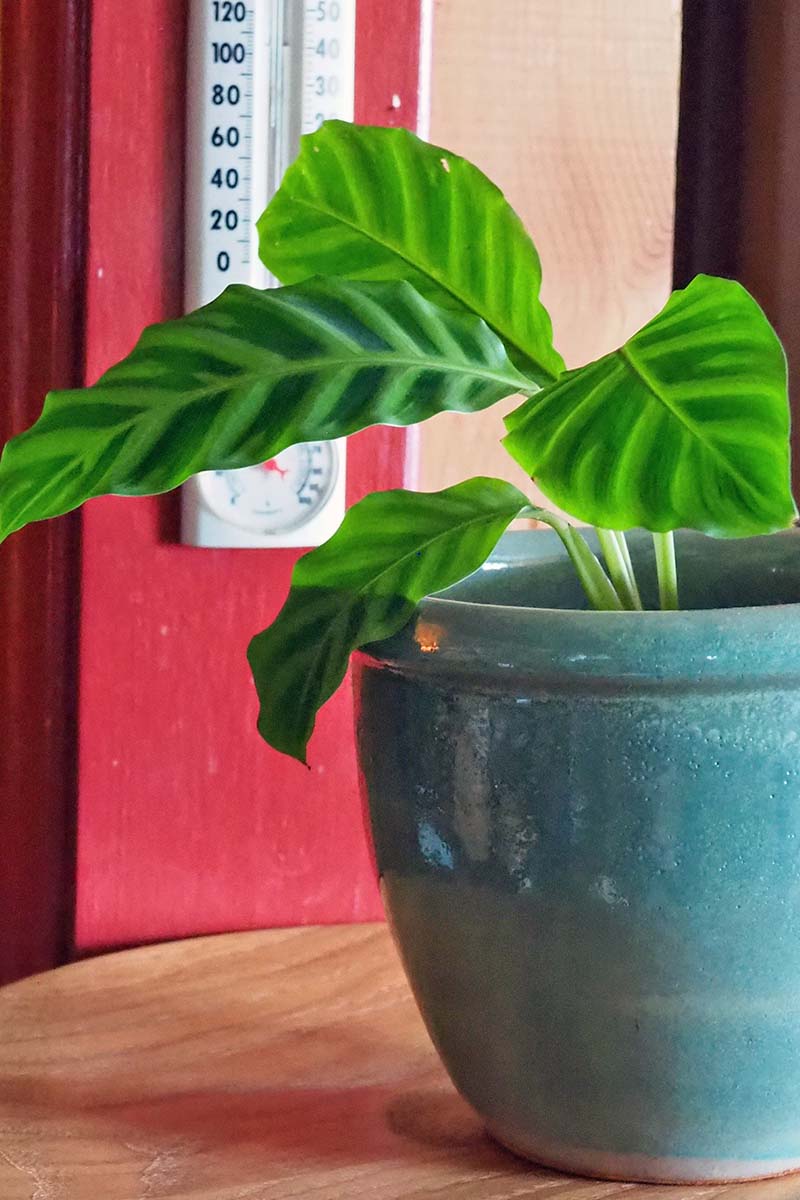
Avoid locating your prayer plants in areas that get very warm. As mentioned, a position too close to a south-facing window may overheat your houseplants, and scorch their foliage.
Also avoid situating them next to fireplaces or radiators, where temperatures are likely to be too extreme.
Since my home has a single heat source in the middle of the house and the temperature in the outer rooms is colder, I keep a thermometer near my calatheas, so I can keep my eye on them and make sure they aren’t getting too much of a chill.
Water
Watering is probably the area of care where you will have to be the most vigilant. These houseplants aren’t ones you can stick in a corner, forget, and expect to be fine and dandy when you finally remember them a month later.
They grow in moist soil in their native range, and they would greatly prefer to continue doing so in the confines of our homes.
And they will let you know when they aren’t happy with your watering routine. They are prone to getting brown leaf tips when watering is either insufficient or inconsistent.

So keep these tropical houseplants in soil that is moist – but not soggy. That means they require well-draining soil and frequent watering. It’s a good idea to check their soil twice a week.
In other sources you may find directions to water when the top half inch or the surface of the soil is dry. Since these houseplants are usually grown in a very peaty growing medium, I find that the surface of the soil doesn’t always dry out by the time they need to be watered.
I prefer to lift the pots my houseplants are growing in to determine when they are thirsty – you can get to know yours as well and make a mental note on how the pot should feel when it’s time to water.
Whatever you do, don’t let them go bone dry between waterings.
When you water, don’t water overhead – instead, pour water just over the soil.
Another important watering tip is to avoid ice cold water, and water your plant babies with room temperature or lukewarm water instead.
Also, remember to remove any saucers or decorative pot covers and let the water drain out of the drainage holes of their nursery pots after watering. Letting them sit in a saucer full of water can cause their soil to become waterlogged.
And since municipal water can contain contaminants and well-water is often mineral-heavy, use rainwater, filtered, or distilled water to give your prayer plants the gentle hydration they need.
Signs that you aren’t watering enough include brown leaf margins or leaf tips, and mature leaves may curl up at the leaf margins – but this is not to be confused with new leaves unfurling.
However, there are also other reasons these houseplants’ leaves can turn brown. Check out our article for troubleshooting tips when prayer plant leaves turn brown.
Humidity
One of the reasons for brown leaf tips on Marantaceae species is insufficient humidity.
Being creatures of the rainforest as they are, prayer plants do best when the humidity is fairly high, between 40 and 60 percent.
Since most of us don’t have such humid conditions in our homes during winter, there are a few different ways you can help increase the amount of moisture in the air for your babies.
While misting these houseplants with a spray bottle can help, it often isn’t enough to increase the moisture in the air around these humidity-loving tropical natives. Here are some other methods to consider:
If you’re looking for an excuse to purchase not just one prayer plant but several of them, you’re in luck. Grouping these houseplants together will help increase the relative humidity around each one.
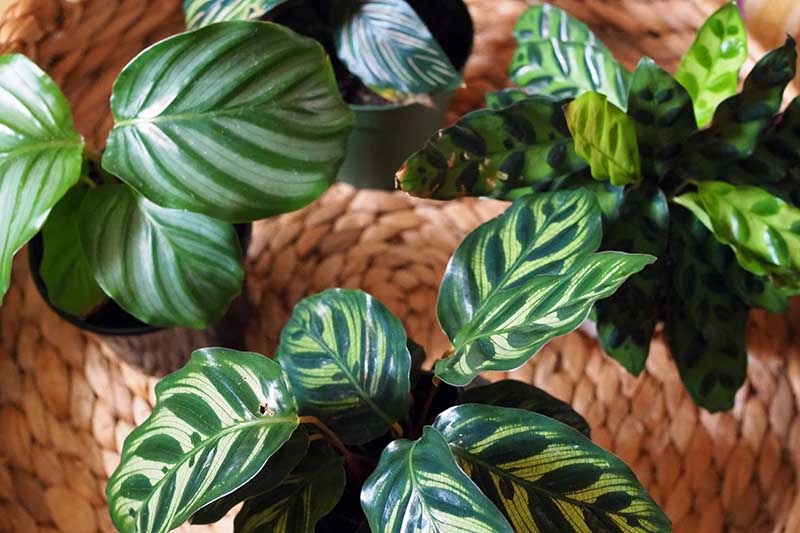
But they don’t have to be grouped among themselves, it will also help to surround them with other types of houseplants that have similar growing requirements, such as spider plants, orchids, or philodendrons.
An additional measure you can use to increase humidity is to place your plant on a humidity tray. Water that is evaporating from the tray will add moisture the air around the plant.
Just make sure the pot is never sitting in standing water – which is a recipe for root rot.
If you’d like to try a humidity tray, you can find one that measures 13.5 inches by 10.5 inches from Humidi-Grow, available via Amazon.

Humidi-Grow 13.5” x 10.5” Humidity Tray
I’m growing my calatheas and maranta in a desert climate, so I have to go to more extreme measures to ensure they get adequate humidity.
My calatheas, which are small, are housed in a terrarium. This not only increases the relative humidity, it also protects them from my cats.
And as for my maranta, which is in a hanging basket and is too large for a terrarium, I keep a humidifier nearby.
Fertilizer
Prayer plants do appreciate a bit of fertilizer, but you’ll need to take a light-handed approach in this domain.
Salts from fertilizer can build up in their soil, competing for moisture and even leaving unsightly tip burns on the foliage.
On the other hand, if your prayer plants are producing small, pale leaves, this may be a sign that they do indeed need fertilizing.
You can use a liquid houseplant fertilizer that you dilute heavily and apply twice a month during the growing season, approximately from March through September.
To prevent a buildup of salts from fertilizers, it’s a good idea to give your plant’s soil a good rinse every few months – water it heavily with fresh water three times in a row, until water runs out from the bottom of the plant’s pot – to help leach out salts that have built up in the soil from fertilizers.
I like to take a gentle, organic approach when fertilizing my houseplants, using worm compost tea to do the job twice a month.
If you don’t have a worm bin of your own to harvest compost from, I recommend TeaDrops, an ingenious product for making instant worm compost tea.

TeaDrops Organic Houseplant Fertilizer
TeaDrops are little “tea” bags that contain worm compost. You soak them in room temperature water for several hours, and then use the brewed “tea” to both fertilize and water your houseplants.
You can find a pack of 16 worm compost tea packets for purchase from the Earthworm Technologies Store, available via Amazon.
Keep in mind that prayer plants are slow growers, and applying excess fertilizer won’t change this.
Growing Tips
- Provide indirect medium or bright light.
- Keep well-draining soil moist but not soggy.
- Provide extra humidity.
Pruning and Maintenance
While marantas, calatheas, stromanthes, and ctenanthes appreciate more weekly attention than, say, snake plants or Christmas cactus, they don’t require a lot of maintenance over the long term.
Pruning
Even with the best care, prayer plants often develop brown tips or leaf edges, and older leaves will fade and die. Any unsightly leaves can be trimmed or removed – they won’t regain their verdant hue.
When trimming brown or yellow foliage, use a clean, sterilized pair of scissors or pruners.
If you are working with a diseased plant, go a step further and make sure to clean the scissors with rubbing alcohol or hydrogen peroxide between each cut.
And even when plants appear healthy, it’s a good idea to sterilize your scissors or pruners between different plants to prevent the spread of potential pathogens.
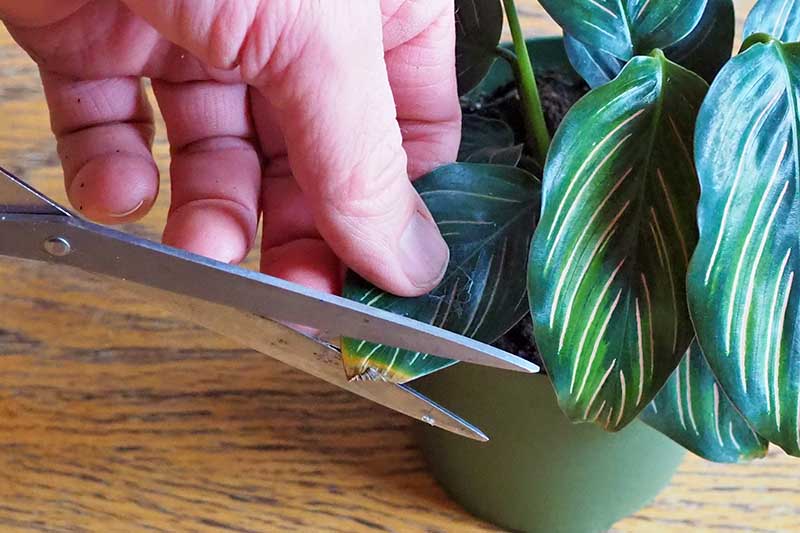
When removing an entire leaf, cut all the way back to the base of the stem. If a leaf has just a tip that is brown, you can trim off the brown tip instead of removing the entire leaf.
Master Gardener Kathy Warner, writing for the University of Florida Nassau County Extension, explains that pruning leaves can encourage the growth of new rhizome clumps – a good technique to keep in mind if you’re interested in propagation.
And if your plant’s foliage ever gets really miserable looking, prayer plants can be cut back close to the soil.
They may eventually produce a new set of foliage – but only, of course, if you determine what the problem is and are able to and remedy it.
Repotting
Another bit of long-term care you will have to provide is repotting your calathea, maranta, stromanthe, or ctenanthe over the years.
Repotting goes hand in hand with good watering practices, so I’m going to go into a lot of detail in this section so that you don’t inadvertently make your prayer plants miserable.
When to Repot
The best time to repot your prayer plant is generally in early spring.
However, if you notice roots emerging on the surface of the soil or roots coming out of drainage holes, that’s a sign that the plant is getting pot bound, and it’s a good idea to go ahead and proceed with repotting.
Also, if your prayer plant is drying out too quickly between waterings – say, if you consistently find you have to water it two or three times a week – it probably needs to be repotted.
Types of Pots
Prayer plants should be moved up one pot size when repotting. If you go to a much larger size, you’ll put your houseplant at risk for root rot since the excess soil may remain too soggy.
The next rule of thumb for picking your pot, after you determine what size you’ll need, is to make sure it has adequate drainage holes in the bottom.
While some gardeners might get away with filling a pot without drainage holes of any sort with rocks or gravel in the bottom, this technique is not a surefire plan to provide the drainage that most houseplants desperately need.

Mold and bacteria can grow on the damp gravel at the bottom of these pots – both of which can turn a healthy plant into a sick one.
So use a plain pot with drainage holes, and then if you want to display something prettier, you can place it inside a more decorative cachepot.
You may want to select your pot material based on your climate. If you live in a humid area or really like to water a lot, a terra cotta pot may be the best choice – it allows water to evaporate readily through the pot.
On the other hand, if you live in an arid climate like I do, plastic tends to be a better option, as it will prevent the potting medium from drying out quite so quickly.
Once you have a pot to use, you’ll need to select a growing medium.
Selecting a Potting Medium
While you may find many sources telling you to pot these in regular houseplant potting mix, that’s probably not ideal. Here’s why:
According to Gary W. Moorman, Professor of Plant Pathology at Penn State University, perlite, a common ingredient in potting soil, shouldn’t be used for Marantaceae species. It contains fluoride which can harm these houseplants, causing brown, burned leaf tips.
As well as avoiding perlite, look for a potting medium that has both good water retention and is extremely well-draining. It should also have a slightly acidic pH.
Most nurseries grow Marantaceae species in a potting medium that includes peat moss for water retention, but I prefer a more ecologically sound, peat-free mix that replaces peat moss with coconut coir – such as De La Tank’s Houseplant Mix.
You can find De La Tank’s Houseplant Mix available for purchase in an assortment of package sizes at Arbico Organics.
Transitioning to a New Container
When your prayer plant is ready to be repotted and you have your new container as well as the right type of soil, you are almost ready to begin your repotting project.

But first, one more thing:
If you are reusing a nursery pot, make sure to clean and sterilize it. Old pots can harbor bacteria and fungi. You can sterilize previously used pots by washing them out with hydrogen peroxide.
Now that you’re ready, place a bit of potting medium into the bottom of the new pot. Then gently remove your prayer plant from its old pot.
If the plant is becoming a bit rootbound, this may require a little more effort – tip the pot sideways and gently squeeze it so that you can remove it.
Gently loosen the edges of the old potting soil and the plant’s roots, so they will have an easier time moving into the new soil.

Place your plant into its new pot and check the level of the soil surface. Adjust the amount of fresh potting soil under the plant and reposition it as necessary, to leave about half an inch of headspace at the top, below the rim.
Now fill the pot in with fresh potting medium – add enough to surround the old potting soil, but don’t pack it in too tightly.
Also make sure you don’t bury the crown of the plant with the fresh potting medium, to avoid the risk of rotting stems.
Water in your freshly repotted plant. Tell it how beautiful it looks (this is optional, but recommended!) and return it to its normal location.
Cultivars to Select
The Marantaceae species have some of the most intriguing foliage you can find among houseplants – at least in the opinion of this writer.
Their leaves come in such a gorgeous array of patterns and color combinations that it’s really hard not to want one of each.
For the purposes of this article, I’m going to showcase one or two species or cultivars from each of these four genera – Ctenanthe, Goeppertia (aka Calathea), Maranta, and Stromanthe.
Ctenanthe Setosa
Native to Brazil, Ctenanthe setosa is a species that has pale silver, paddle-shaped leaves with a medium green fishbone pattern.

The undersides of the leaves are a purple color, which is displayed before new leaves unfurl, and when C. setosa raises its foliage as the sun goes down at night.
Also called “never never plant,” C. setosa is on the larger size for a prayer plant, growing to be four to five feet in height and two to three feet wide at maturity.
Goeppertia Concinnea
Goeppertia concinnea is a species that has pale green leaves with a fine, medium green herringbone pattern.
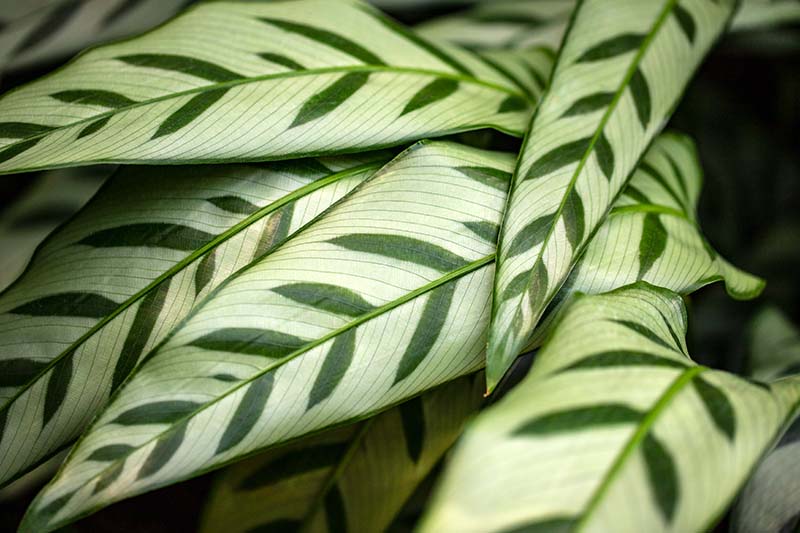
The leaves are long, narrowing to a point, and have pale green undersides.
Also known as Calathea leopardina, this species is fairly compact, growing to be up to two feet tall. It is native to Brazil.
Goeppertia Roseopicta ‘Royal Standard’
This cultivated variety of G. roseopicta has wide, oval leaves that come to a point. They are silver with wide, dark green margins, and the bottom sides of the leaves are a lovely mauve or purple hue.

‘Royal Standard’ is taller than it is wide, reaching a height of two to three feet with a spread of one to two feet.
If you’re looking to purchase this one, you may find it listed under its old name as Calathea ‘Royal Standard,’ so keep this in mind when you are shopping.
Maranta Leuconeura var. Erythroneura
Maranta leuconeura var. erythroneura is a naturally occurring variant of this species, commonly known as “red prayer plant.”
It is also often called “red vein maranta,” “red veined prayer plant,” or “herringbone plant,” and is sometimes classified taxonomically as Maranta leuconeura ‘Tricolor.’
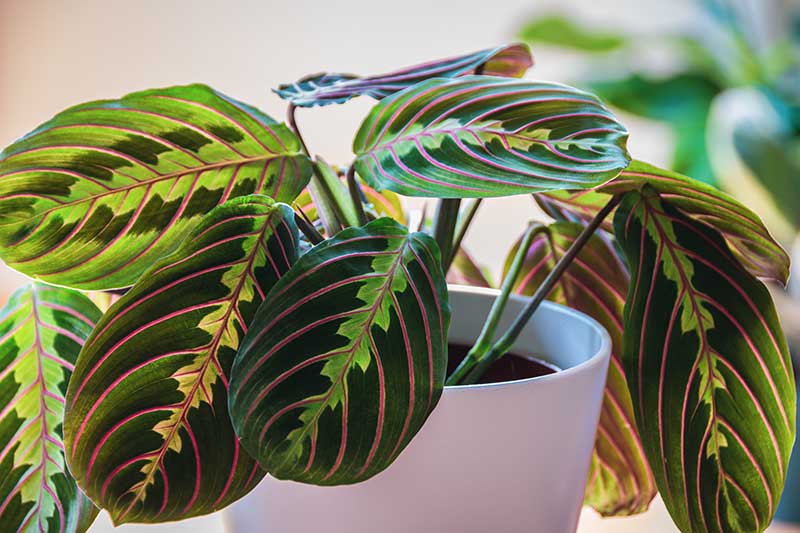
Red vein maranta has rounded, elliptical leaves that are dark and light green, with a yellow or light green blaze along the leaf center, and contrasting bright red veins and midribs.
Mature plants grow to be one and a half feet tall with a spread of one to one and a half feet.
This naturally occurring variety won a Royal Horticultural Society Award of Garden Merit in 2002, in the ornamentals category.
You’ll find an eight- to 15-inch-tall red vein maranta plants available for purchase at Terrain.
Stromanthe Thalia ‘Magic Star’
‘Magic Star’ is a cultivated variety of Stromanthe thalia, sometimes listed under the synonymous species name S. sanguinea, or erroneously described as ‘Magic Star’ calathea.
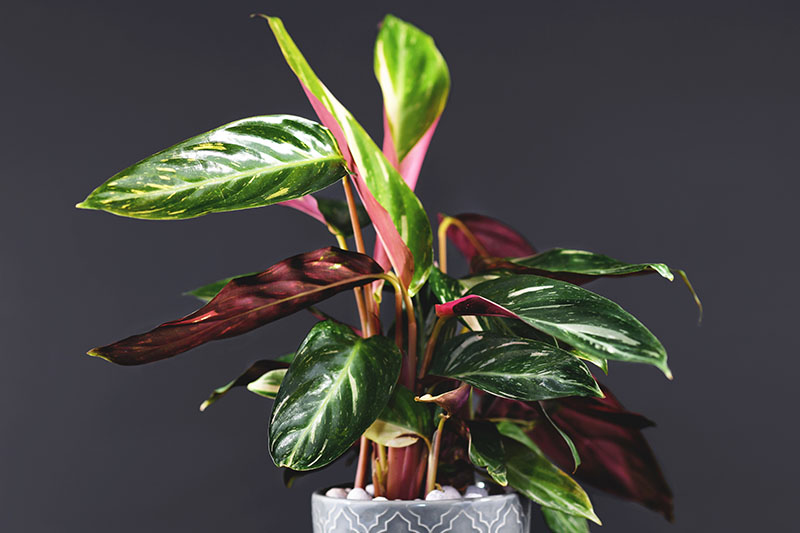
When seeking out a specimen to purchase, a search for “Magic Star stromanthe” should help you to find what you’re looking for.
This cultivar has an upright growth habit, with a mature height of about two feet tall. Lance-shaped leaves are dark green in color with small splashes of white variegation, and dark pink to purple undersides.
If you’re like me and you can’t get enough of these gorgeous species, make sure you peruse our article on the different types of prayer plants, where you’ll be able to learn about 21 recommended varieties.
Managing Pests and Disease
These houseplants aren’t particularly susceptible to pests or diseases. The biggest risk to their health is probably owner error – providing either too much sunlight, or too much or too little water.
However, in the event that pest or disease problems arise, it’s good to know what to be on the lookout for.
Insects
If you take these houseplants outside for the summer, you can expect a higher risk of pest problems. That’s one of the reasons why I like to keep mine inside year-round.

But there are also a few common houseplant pests that can prey on these ornamental species indoors.
Mealybugs
Mealybugs can pop up on just about any of your houseplants. Once you know how to spot them, they’re almost impossible to miss.
Members of the scale family, mealybugs have an easily recognizable white fluffy look that can make your houseplants appear as if they’ve been covered with a light dusting of snow – particularly on stems and petioles.
Like aphids, mealybugs secrete honeydew, and sooty mold can grow on this sticky liquid, causing yet another problem for your houseplant to struggle with.
Severe infestations can cause stunting and parts of the plant will begin to die.
Mealybugs can be controlled by removing them with rubbing alcohol. Just get a paper towel damp with rubbing alcohol and then rub away the pests.
Make sure to perform this task when your plants are not going to be exposed to high heat, or direct sunlight.
Neem oil can also be used. Follow the manufacturer’s instructions for applying this product.
You can find Monterey brand neem oil available from Arbico Organics.
Scale
Scale insects enjoy feasting on these Marantaceae family members as much as they do on your other houseplants. Related to mealybugs, scale insects have a non-insectile appearance.
When infected with scale insects, leaves and stems will have small round or oval brown or tan spots on them. These insects don’t move much and they often cluster close together, so you may see solid patches rather than individual spots.
When scale insects infest your prayer plant, they latch onto it with their mouth parts and set up a cozy life, sucking away the plant’s nutrients.
This eventually takes much-needed nutrients away from the plant, which can result in sickly looking, yellow leaves. The plant can become stunted and eventually die.
To treat scale, you have the same options as with mealybugs. You can treat your plants by rubbing the scale insects away with rubbing alcohol, or you can apply neem oil.
Find more tips on identifying and control scale insects here.
Spider Mites
Spider mites are another type of nutrient-sucking foe to be on the lookout for.
The first sign of their presence might be leaves stippled with yellow. With more severe infestations you’ll notice webs around the foliage, and you may see tiny colonies of red or brown mites moving around in the webs or on your plant.
On the undersides of leaves you might notice a gray powdery substance – this is skin shed by the spider mites.
Like mealybugs and scale, these pests damage plants by sucking nutrients out of their leaves, which can result in sick, undernourished plants.
To remove spider mites, first try simply wiping them away with a damp paper towel. If the problem persists, treat with rubbing alcohol or neem oil.
Get more tips on combating spider mites here.
Disease
Luckily, prayer plants aren’t often affected by disease when they are kept indoors by home gardeners.
However, there are a few potential pathogens and resulting ailments you’ll want to be aware of.
Cucumber Mosaic Virus
Cucumber mosaic virus is one disease that can affect marantas, stromanthes, ctenanthes, and calatheas. It creates a telltale mottled yellow coloring on your plant’s foliage.
You may be more familiar with this disease showing up in your vegetable garden – it can also affect zucchini and other cucurbits, as well as many other garden plants.
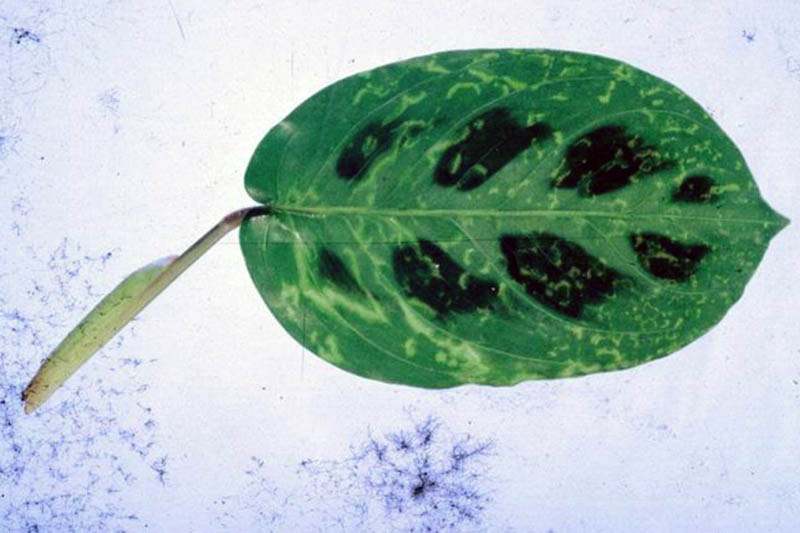
Cucumber mosaic virus can be spread by aphids, contaminated garden tools, or even dirty fingers.
To prevent inadvertently spreading this disease, make sure to sterilize tools and thoroughly wash your hands as well, in between caring for different specimens.
There are no chemical controls available to control this virus. Unfortunately, your only option in case of infection is to discard infected specimens in order to prevent spread to your other houseplants.
Helminthosporium Leaf Spot
Helminthosporium leaf spot is a fungal disease that causes small yellow spots on the foliage that gradually grow larger, into irregularly shaped tan spots with yellow halos.
This disease is caused by the fungal pathogen Drechslera setariae, and can arise when leaves stay wet for several hours.
Helminthosporium leaf spot can be prevented by avoiding overhead watering. Also, water only in the morning, giving foliage time to dry before temperatures cool.
If this disease shows up on your prayer plants, make sure to adjust your watering habits to prevent prolonging the outbreak.
Then treat your plant with neem oil, a natural, nontoxic fungicide.
Root rot
Root rot is the disease most likely to strike your prayer plants, but luckily this problem is easily prevented.
If you keep your houseplants in well-draining soil, are careful not to overwater, and avoid letting them sit in standing water, you can keep this disease at bay.
Root rot is one of those problems that can cause leaves to yellow, so if you notice this symptom on your prayer plant, make sure its soil isn’t waterlogged.
When roots are left in waterlogged soil, they are not able to take up enough oxygen and will die and decay. Ironically, the plant then becomes dehydrated because its roots cannot ferry water up to its leaves.
If you suspect root rot is affecting your prayer plant, repot it. During the repotting process, gently remove the soil from the roots and prune off any dead or decaying ones. Repot in a well-draining potting medium and avoid oversaturating it.
Also, go ahead and prune any yellowing leaves, since they will not recover.
Insect and disease problems aren’t the only reasons for yellow leaves on these houseplants. Check out our article on troubleshooting yellowing leaves on prayer plants to learn more.
Best Uses
Members of the Marantaceae family are excellent houseplants. The spreading types can be grown in hanging baskets or be allowed to drape over decorative stands.
And those with a more upright growth habit can be placed in decorative pots and situated to brighten up an entrance table, mantlepiece, or an empty corner.
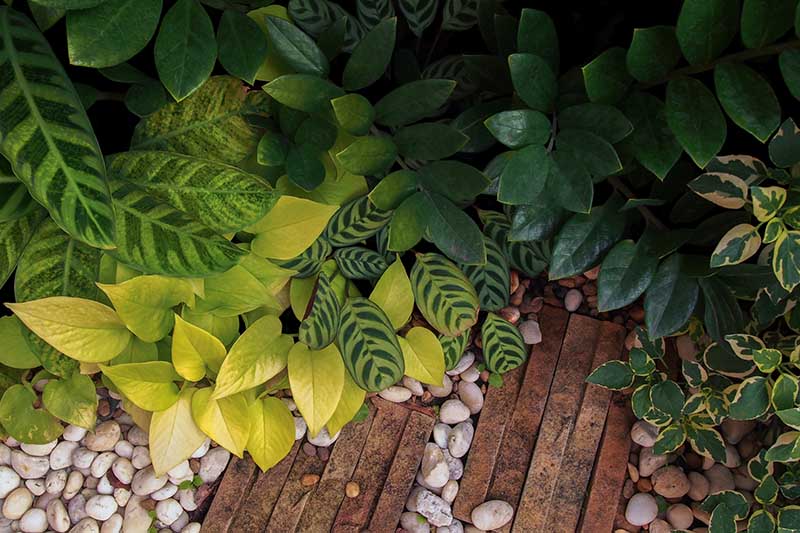
They also make good selections for interiorscapes, which are large, vegetative features in indoor spaces such as office buildings or malls.
Another laudable feature of these tropical species is that they are nontoxic, safe to keep around when you have a house full of kids or pets.
And when used indoors, they may also improve air quality by reducing CO2 levels – even when grown in low light conditions.
While prayer plants are most often used as ornamental houseplants, for those who live in Zones 11 and 12 or a comparable climate, they can be grown in the landscape.
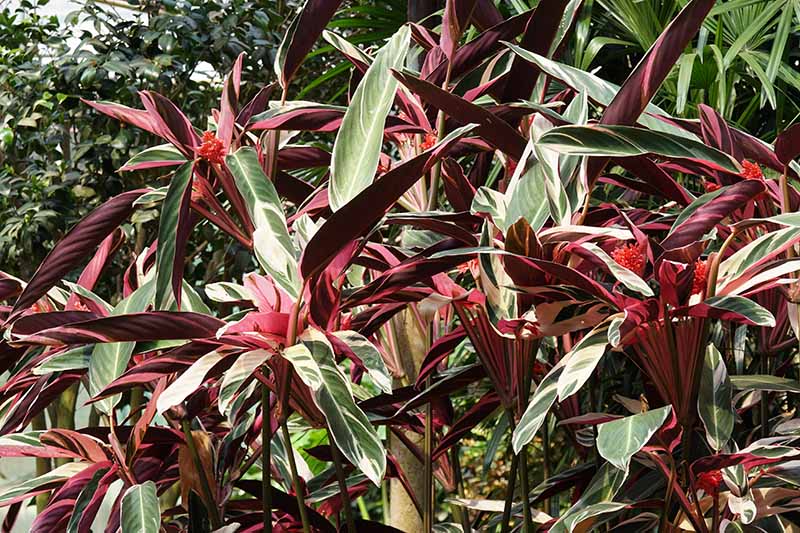
Many species make excellent ground covers with their spreading forms, such as marantas and ctenanthes. Others with a more upright growth habit, such as Stromanthe thalia ‘Tricolor,’ can be used as a focal point or to echo other colors in a tropical landscape.
Quick Reference Growing Guide
| Plant Type: | Evergreen herbaceous perennial | Foliage Color: | Dark green, light green, pink, purple, red, cream, silver |
| Native to: | Asia, Africa, the Americas | Soil Type: | Peaty, rich |
| Hardiness (USDA Zone): | 11-12 | Soil pH: | 5.5-6.5 |
| Exposure: | Medium to bright indirect light | Soil Drainage: | Well-draining |
| Height: | 6 inches to 5 feet | Companion Planting: | Begonia, monstera, orchid, philodendron, pilea, sansevieria, spider plant |
| Spread: | 8 inches to 3 feet | Uses: | Ornamental houseplant; Groundcover or foliage plant in Zones 11-12 |
| Tolerance: | Humidity | Order: | Zingiberales |
| Water Needs: | Medium | Family: | Marantaceae |
| Maintenance: | Moderate | Genera: | Goeppertia (aka Calathea), Ctenanthe, Maranta, Stromanthe |
| Common Pests: | Aphids, fungus gnats, mealybugs, root knot nematodes, scale, spider mites | Common Diseases: | Cucumber mosaic virus, helminthosporium leaf spot, pyricularia leaf spot, root rot |
Nyctinastic and Fantastic
While prayer plants may not be the most low-maintenance houseplants, with their marvelous leaf patterns and daily raising and lowering of their leaves, they are among the most rewarding.
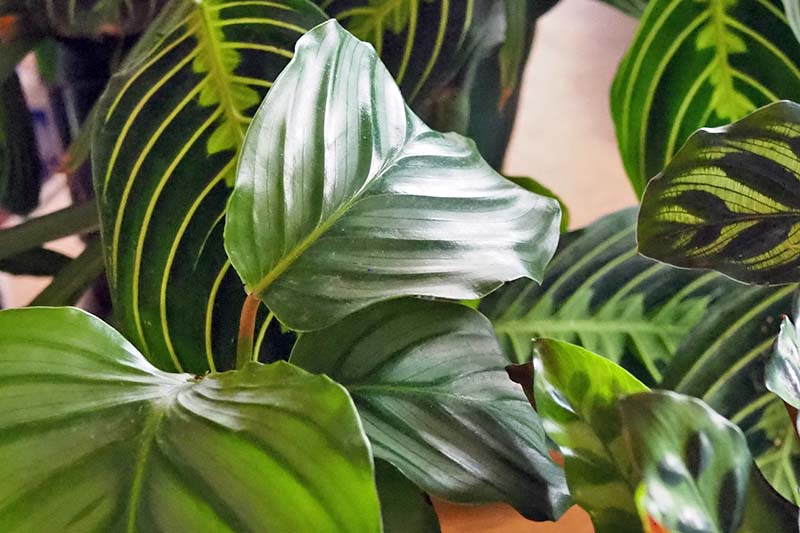
Remember to provide them with indirect light and well-draining soil. Keep the soil moist but not soggy, and provide extra humidity to keep them at their happiest.
Have you grown marantas, calatheas, stromanthes, or ctenanthes before? Are you cultivating a collection like I am? Let us know in the comments section below, and feel free to share a photo!
Ready to read more about the various species within the prayer plant family? Check out these next:
- How to Grow Stromanthe Triostar Houseplants
- How to Grow and Care for Calathea Zebrina Plants
- How to Grow and Care for Rattlesnake Plant
- How to Grow and Care for Pinstripe Plant
Photos by Kristina Hicks-Hamblin © Ask the Experts, LLC. ALL RIGHTS RESERVED. See our TOS for more details. Product photos via California Tropicals, Humidi-Grow, Monterey, Soil Mender, and Terrain. Uncredited photos: Shutterstock.
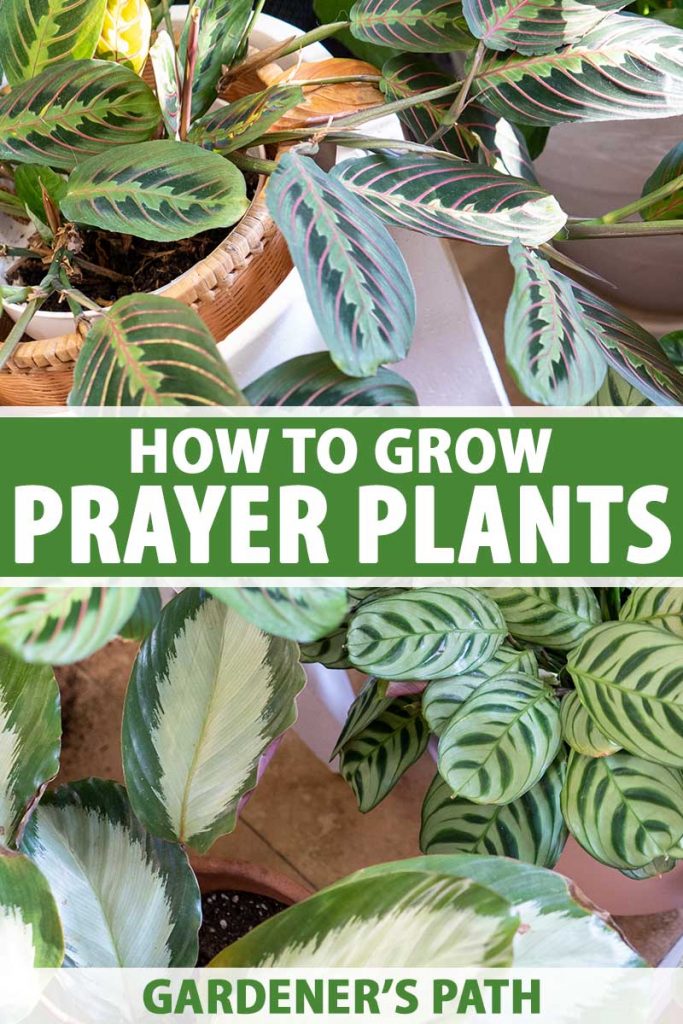
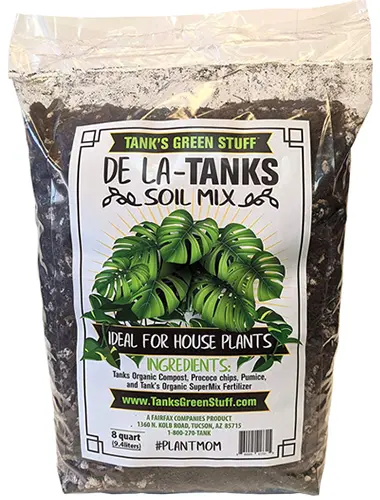
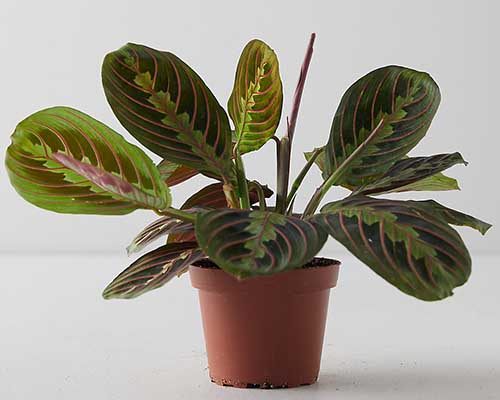
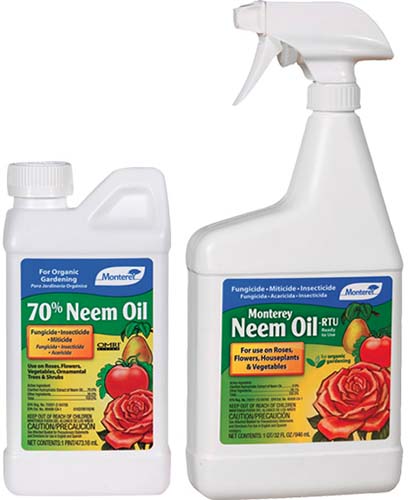
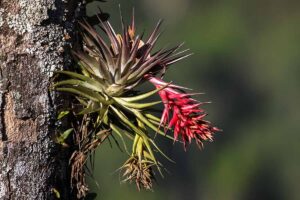
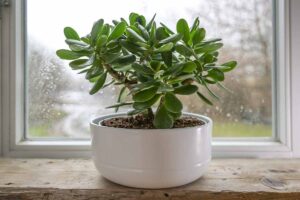

How long do they go thru transplant shock
Hi Janice, Not all prayer plants will show signs of transplant shock. If yours is showing these symptoms, the most likely causes are either changing to a different soil type or disturbing or damaging the roots during re-potting. I would give the plant a few days to a week to recover. If it doesn’t seem to improve after that, you might want to look at some other possible causes. Please check out our articles on brown leaves on prayer plants, and there’s another on yellow leaves on these plants. Both of these articles should help you troubleshoot what might be… Read more »
Hey!
Here’s my prayer plant.
She’s flowering and growing air roots!
No clue what I’m doing right, but I just keep going!!
Hey!
Here’s my prayer plant.
She’s flowering and growing air roots!
No clue what I’m doing right, but I just keep going!!
Do you know why it’s growing air roots! I don’t want to trim and propagate them, but I don’t want it to get sad either!!
Hi Jan, Thanks for posting your photos. Apparently air roots on prayer plants are fairly uncommon. Your photo is a little hard to make out and the protrusion doesn’t look like other prayer plant air roots I’ve seen before. I’m not saying it’s not an air root for sure, but I wonder if it might be a stem that hasn’t unfurled any leaves yet? As I said, it’s a little hard to tell for sure based on the photo. Let’s call it a potential air root. In any case, I would recommend taking your plant out of its pot to… Read more »
Hi! I have a Peacock prayer plant and when I first brought it home it was doing wonderful! Now all of the sudden the leaves are turning yellow, but also have some brown along the edges. I’ve gone through and trimmed off the yellow and brown edges, and removed the yellow leaves. Some of the leaves appear slightly droopy as well, they aren’t closing at night anymore. I had it in a corner with indirect sunlight but my air conditioning vent was blowing cold air on it, so I moved it and am running a humidifier next to it to… Read more »
Hi Kylinn, I think the cold air from the air conditioner may have been the problem, as you guessed. These plants really don’t like hot or cold air blowing on them. Also, do make sure you are watering it enough. It’s pretty hot in my house right now and I have to water my prayer plants much more frequently than usual. I think the humidifier is also a great idea. See if these things help it re-establish its normal daily rhythm before you try anything else. If it doesn’t improve, feel free to come back, and please post a photo!… Read more »
Hi
I have a Calathea. I have had it over a month. It was doing well and it has two new leaves. However, the last few days the leaves haven’t been closing up. Can you tell me what is causing that to happen?
Hi Judy, Thanks for posting your question here. There are a couple of different reasons that might cause your calathea to stop raising and lowering its leaves. Have the lighting conditions changed? Is the plant in a room where there is always a light on? Or perhaps a light coming from outdoors? If these plants get their night and daytime rhythms disturbed by lack of light or lack of darkness, they will, after a couple of days, stop raising and lowering their leaves. Another possible explanation is that it is not getting enough water and / or is under heat… Read more »
Hi! You wrote that perlite is bad for these plants but the potting soil you recommended has perlite in it. Please clarify.Thanks for all the wonderful information you share about plants.
Hi Patrice,
Thanks for your comment. I think that the potting medium that I originally recommended in this article (Soil Mender 109) may have changed its formula since this article was first published. I have a new favorite growing medium for prayer plants and will make sure this article gets updated with this better option. In the meantime, here it is: De La Tank’s House Plant Mix, available in a 1-quart bag via Amazon.
Sorry for the confusion and hope this helps!